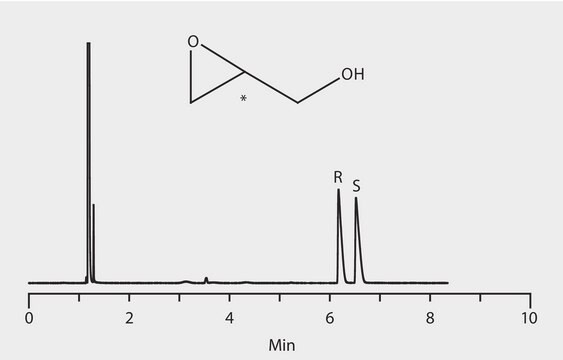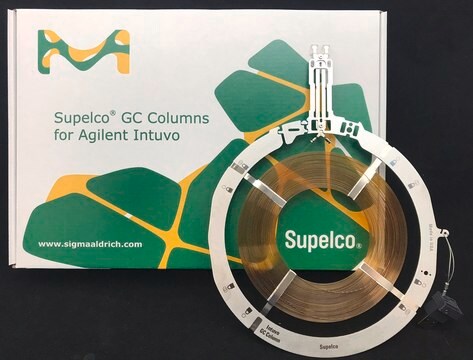73033AST
Astec® CHIRALDEX™ G-TA Capillary GC Column
L × I.D. 30 m × 0.25 mm, df 0.12 μm
Recommended Products
material
fused silica
description
GC capillary column
packaging
pkg of 1 ea
parameter
-10-180 °C temperature (isothermal or programmed)
Beta value
500
df
0.12 μm
technique(s)
gas chromatography (GC): suitable
L × I.D.
30 m × 0.25 mm
matrix active group
non-bonded; 2,6-di-O-pentyl-3-trifluoroacetyl derivative of γ-cyclodextrin phase
application(s)
agriculture
chemicals and industrial polymers
cleaning products
clinical
cosmetics
environmental
flavors and fragrances
food and beverages
forensics and toxicology
life science and biopharma
personal care
pharmaceutical (small molecule)
column type
capillary chiral
separation technique
chiral
Looking for similar products? Visit Product Comparison Guide
Related Categories
General description
Application
Chem/Phys Resistance
- -10 °C to 180 °C isothermal and programmed
Other Notes
Legal Information
Certificates of Analysis (COA)
Search for Certificates of Analysis (COA) by entering the products Lot/Batch Number. Lot and Batch Numbers can be found on a product’s label following the words ‘Lot’ or ‘Batch’.
Already Own This Product?
Documents related to the products that you have purchased in the past have been gathered in the Document Library for your convenience.
Difficulty Finding Your Product Or Lot/Batch Number?
How to Find the Product Number
Product numbers are combined with Pack Sizes/Quantity when displayed on the website (example: T1503-25G). Please make sure you enter ONLY the product number in the Product Number field (example: T1503).
Example:
Additional examples:
705578-5MG-PW
PL860-CGA/SHF-1EA
MMYOMAG-74K-13
1000309185
enter as 1.000309185)
Having trouble? Feel free to contact Technical Service for assistance.
How to Find a Lot/Batch Number for COA
Lot and Batch Numbers can be found on a product's label following the words 'Lot' or 'Batch'.
Aldrich Products
For a lot number such as TO09019TO, enter it as 09019TO (without the first two letters 'TO').
For a lot number with a filling-code such as 05427ES-021, enter it as 05427ES (without the filling-code '-021').
For a lot number with a filling-code such as STBB0728K9, enter it as STBB0728 without the filling-code 'K9'.
Not Finding What You Are Looking For?
In some cases, a COA may not be available online. If your search was unable to find the COA you can request one.
Which document(s) contains shelf-life or expiration date information for a given product?
If available for a given product, the recommended re-test date or the expiration date can be found on the Certificate of Analysis.
How do I get lot-specific information or a Certificate of Analysis?
The lot specific COA document can be found by entering the lot number above under the "Documents" section.
How do I find price and availability?
There are several ways to find pricing and availability for our products. Once you log onto our website, you will find the price and availability displayed on the product detail page. You can contact any of our Customer Sales and Service offices to receive a quote. USA customers: 1-800-325-3010 or view local office numbers.
What is the Department of Transportation shipping information for this product?
Transportation information can be found in Section 14 of the product's (M)SDS.To access the shipping information for this material, use the link on the product detail page for the product.
What is the regeneration procedure for Chiraldex TA columns?
The regeneration procedure for ChiraldexTA columns is located in Supelco brochure, T407123 (JCH), A Guide to Using Cyclodextrin Bonded Phases for Chiral Separations by Capillary Gas Chromatography, on pages 8 and 9. These pages are attached.
My question is not addressed here, how can I contact Technical Service for assistance?
Ask a Scientist here.
Articles
Amino acids are building blocks of peptides and proteins. Enantiomeric separation of these molecules can be performed through chromatography by chiral stationary phases. This article describes the chiral GC analysis of one amino acid, proline, after achiral derivatization.
In this study we demonstrate the separation of D- and L-carvone enantiomers in samples of caraway seed, dill seed, native spearmint and scotch spearmint essential oils using an Astec CHIRALDEX G-TA capillary GC column.
Protocols
GC Analysis of D-Carvone Enantiomer in Caraway Essential Oil on Astec® CHIRALDEX® G-TA
Chromatograms
suitable for GCsuitable for GCsuitable for GCsuitable for GCShow MoreOur team of scientists has experience in all areas of research including Life Science, Material Science, Chemical Synthesis, Chromatography, Analytical and many others.
Contact Technical Service

